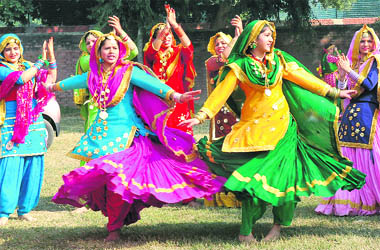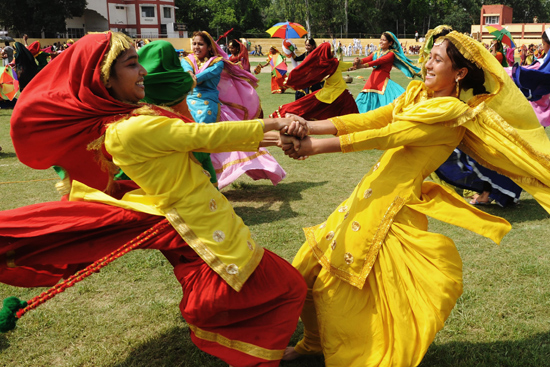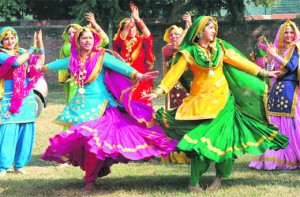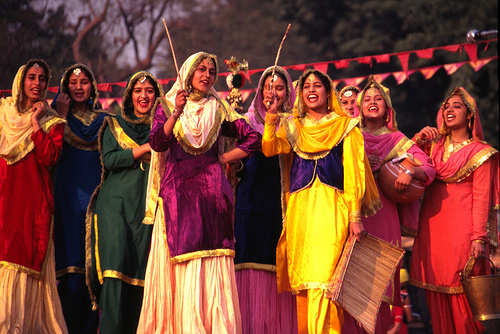
Giddha
It is a popular folk dance of Punjab that is performed only by the ladies. This dance is the female counterpart of the Bhangra, and has the same tempo of high-spirited revelry. Gidha is performed during festive or social occasions, especially during the sowing and reaping of the harvest. The roots are deep rooted in Punjab’s culture and are believed to be inspired from the ancient ring dance which is marked by graceful movements and high energy. Bright clothes, rhythmic clapping, and traditional folk songs blend in to transform the dance into a spontaneous display of joy.
Origin and history
The legend has it that it originated from the ancient ring dance that was quite dominant in Punjab. The energy levels in Giddha are the same as that in Bhangra which is performed by men in Punjab. Giddha is performed only by the ladies and hence the viewers get to watch the feminine grace that the female dancers bring to the performance. The ring dance from which Giddha has taken inspiration was usually performed at social occasions by the women and Giddha too is quite popular at most joyous occasions held in Punjab.
Style
For proper execution of any folk dance it is very important to don proper costumes and accessories as these things are as important as the steps involved in the dance. Now that you know about the origin of Giddha let’s move on to the part where you find out about the vibrant Punjabi salwar suit and jewelry worn by the women participants of the dance. Elegance is one of the many features that define this dance form and the costume for this dance is very simple. In fact, you will find the women living in rural Punjab wearing the dress almost every day.
The only major difference you will observe in the everyday clothes and costume is that the latter is much more vibrant and is teamed up with heavy jewelry. If you break down the whole costume then the dress includes the salwar kameez and dupatta. Salwar is primarily baggy pants and the kameez is the colorful shirt worn on the upper body. The dupatta is much like the stole that is matched with the salwar and kameez. The salwar kameez is generally quite vibrant in color and is decorated with heavy work and embroidery.
Mostly the women performing the Giddha choose to wear the salwar kameez but there are occasions when they also don lehenga choli which is a long skirt with a blouse and a dupatta. Now coming to the accessories that are worn with the dress, without these the whole costume of Giddha is truly incomplete. To begin with there is tikka which is for the forehead, jhumkas or earrings for the ears, raani haar or a long neck piece of pure gold for the neck, anklets or payal for the ankles and baazu band which are for the upper arm. The jewelry also includes the matching bangles and the nose ring. Women also wear the paranda also known by the name of braid tassel. The paranda is the vital part of a Giddha costume and cannot be missed by any chance.
Besides the costume and the jewelry, the music used for the dance also plays a vital role in defining the uniqueness of the dance. Usually, there are no instruments involved apart from a dhol which extends the rhythm required for Giddha. Mostly the participants of the dance prefer clapping as a source of rhythm.
Innovations
There are no notable innovations that have taken place in the steps or performance of Giddha dance. It began as a joyful dance and it still is known as a lively, energetic dance form which is performed with grace and elegance by charming Punjabi women.
Global influence
The popularity is not restricted to Punjab or even India as it has spread its glory across the globe. Places such as London, Edmonton, Los Angeles, San Francisco and Vancouver are definitely not alien to this folk dance and this dance is also very popular in Pakistan.
Interesting facts and comparisons
- Mimicry is quite popular when it comes to Giddha and this dance depicts the scenes from the routine life of village women from Punjab.
- The Giddha songs are popularly addressed as bolis and these bolis are sung by the performers of the dance.
- It is generally performed in complete harmony and it is known for its energetic and vigorous nature.
References
Categories: Cultural Connections, Indian Performing Arts



